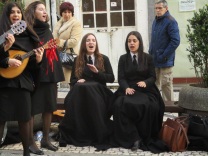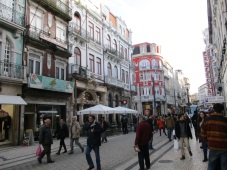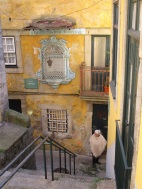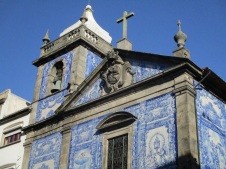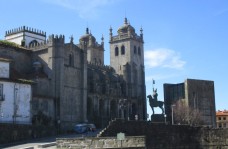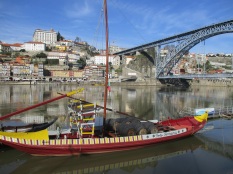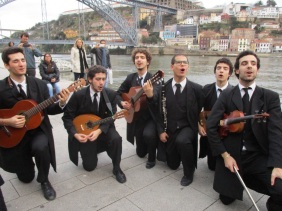 A crackling fire in the common room of the charming hostel where I stayed just outside the fortified walls of Elvas, Portugal, was an inviting place for guests to gather one evening and share stories of a day’s adventure in the historic city.
A crackling fire in the common room of the charming hostel where I stayed just outside the fortified walls of Elvas, Portugal, was an inviting place for guests to gather one evening and share stories of a day’s adventure in the historic city.
Some of our clothes, soaked from walking in the rain that day, were draped strategically over chairs near the fireplace. We found umbrellas useless in the high winds. Pedro, the owner of the hostel (see photo), kept a watchful eye on the fire as the evening progressed.
The lights that illuminated the city walls helped guide us back to the hostel that cool, misty night.
 From the middle 1600’s until modern times, Elvas served as a garrison border town. Over the centuries numerous hilltop fortresses guarded the long border with Spain. Elvas, a UNESCO World Heritage site, was a significant one of these war fortresses with a unique dry-ditch defense system and outlying fortresses which served as lookouts for invaders.
From the middle 1600’s until modern times, Elvas served as a garrison border town. Over the centuries numerous hilltop fortresses guarded the long border with Spain. Elvas, a UNESCO World Heritage site, was a significant one of these war fortresses with a unique dry-ditch defense system and outlying fortresses which served as lookouts for invaders.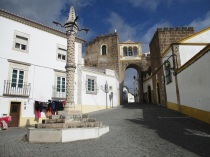
Elvas has a beautifully restored main plaza which is anchored by a 16th century cathedral. Its modest exterior is in sharp contrast to the exquisite craftsmanship found within. The interior is a treasure of high Gothic arches, marble pillars, beautiful paintings, and finely-carved wooden details.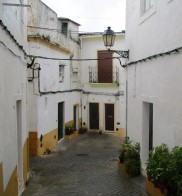
Steep, narrow, cobbled streets lead to small, hidden plazas. The labyrinth of streets was designed and built by the Muslim Moors, one of several occupying forces of the city. I discovered a small brass plaque on a crumbling wall which identified the entrance to the old Jewish Quarter where a gate once stood.
Over the centuries Elvas was three successive walled towns and contains many remnant walls from its turbulent history. I followed an occasional muddy path, passed through deep archways, climbed up and down long ramps, and walked over wooden draw bridges that spanned deep, green ditches.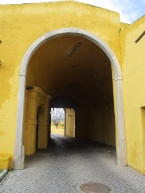 Traditional eateries and inviting pastry shops were never far away.
Traditional eateries and inviting pastry shops were never far away.  I often made a detour at a local bakery when I caught a whiff of freshly-baked bread. The Castelo, Elvas’ small, but highly fortified castle, offered dramatic views of the plains stretched out beyond.
I often made a detour at a local bakery when I caught a whiff of freshly-baked bread. The Castelo, Elvas’ small, but highly fortified castle, offered dramatic views of the plains stretched out beyond.
The grand Amoreira Aqueduct which was built in the late 16th and early 17th centuries dominates the countryside outside the city, stretching for miles. 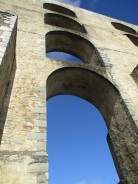 In addition to supplying water to Elvas, the purpose of this imposing structure was to enable the stronghold to withstand a lengthy siege. I felt dwarfed standing under its tiers of arches which extended up to 40 meters (130 feet) high at some points.
In addition to supplying water to Elvas, the purpose of this imposing structure was to enable the stronghold to withstand a lengthy siege. I felt dwarfed standing under its tiers of arches which extended up to 40 meters (130 feet) high at some points.
My last night in Elvas I was the only guest in the hostel, so I had the fireplace all to myself. In this peaceful, cozy setting, I sat in a big easy chair, my feet propped up to receive the fire’s warmth, some bread, cheese and hot tea at my fingertips, and my computer on my lap. I proceeded to write this blog posting, finishing it as the last embers faded.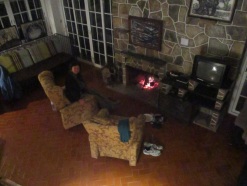
My visit to Elvas was magical.
(Move your cursor over each photo for caption/description, double click open to view larger image. Then use “back” button to return to this page)


